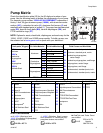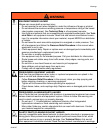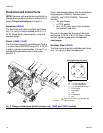
Installation
8 312877C
Check your system electrical continuity after
the initial installation, and then set up a regular
schedule for checking continuity to be sure
proper grounding is maintained.
Air Line
See FIG. 3 and FIG. 4, pages 10 and 11.
1. Install an air regulator (C) and gauge to
control the fluid pressure. The fluid stall
pressure will be the same as the setting of
the air regulator.
2. Locate a bleed-type master air valve (B)
close to the pump and use it to relieve
trapped air. Be sure the valve is easily
accessible from the pump and located
downstream from the regulator.
3. Locate another master air valve (E)
upstream from all air line accessories and
use it to isolate them during cleaning and
repair.
4. An air line filter (F) removes harmful dirt
and moisture from the compressed air
supply.
5. Install a grounded, flexible air hose (A)
between the accessories and the 1/2 npt(f)
pump air inlet (D). Use a minimum 3/8 in.
(10 mm) ID air hose.
Remote option: Insert 5/32 OD tubing into the
push-to-connect fitting at each pilot and route
to your control.
Reed Switch
Pulse Count models are intended for use with
customer-supplied fluid management or inven-
tory tracking systems. Attach an M12, 5-pin
female cable to connect the reed switch to your
data monitoring system. See Manual 406824.
Air Exhaust Ventilation
The air exhaust port is 3/4 npt(f). Do not
restrict the air exhaust port. Excessive exhaust
restriction can cause erratic pump operation.
To provide a remote exhaust:
1. Remove the muffler (T) from the pump air
exhaust port.
2. Install a grounded air exhaust hose (U) and
connect the muffler (T) to the other end of
the hose. The minimum size for the air
exhaust hose is 3/4 in. (19 mm) ID. If a
hose longer than 15 ft (4.57 m) is required,
use a larger diameter hose. Avoid sharp
bends or kinks in the hose.
3. Place a container at the end of the air
exhaust line to catch fluid in case a dia-
phragm ruptures. If the diaphragm rup-
tures, the fluid being pumped will exhaust
with the air.
Trapped air can cause the pump to cycle
unexpectedly, which could result in serious
injury from splashing.
NOTICE
Pilot supply pressure should not exceed
main air supply pressure. If pilot supply
pressure is too high, the pump could leak
air or exhaust excessive air at stall.


















